How to use a dishwasher: rules for use and care of the dishwasher
Regular maintenance of the dishwasher is the key to long-term operation without repairs, leaks and emergency situations. Cleaning, selection of detergents and proper loading ensure uninterrupted operation of the unit in any selected mode. Before testing the programs, carefully read the instructions and the article we presented.
We will talk about how to use the dishwasher in order to further observe the basic rules of care. We will introduce you to the nuances of operation and guidelines for choosing the most suitable means for your machine. Based on our tips, you can maximize the working life of the machine.
The content of the article:
Getting Started
Manufacturers require, and this is stated in the instructions for use, before first launch be sure to test the car in idle mode, that is, without dishes. Flushing will remove fine debris and grease residues and help you understand how the mechanism works.
During the test run, you can determine whether the water is heating and how quickly it leaves the washing chamber. Also, the user will be able to detect installation errors: whether wires or hoses are pinched, if there are any leaks at the connection points.
Testing is carried out according to all washing rules, but without dishes. Select a mode that determines the specifics of processing and washing cycle, it is possible by pressing one button or by the key combination indicated in the instructions. After the rinsing process is completed successfully, you need to wait until the machine cools down and carry out the first wash, but with a full load.
An example of preparation for the first launch using the built-in Flavia model as an example:
If all the preparatory steps are completed correctly, the machine will turn on automatically when the door is closed. The first washing process is best monitored to make sure that the unit is in good working order and to avoid troubles associated, for example, with incorrect loading.
After the end of the cycle, wait 10-12 minutes for the dishes and the internal parts of the PMM to cool. Then they take out the utensils and carefully examine it to make sure the quality of the wash.
If there are traces of food on the dishes, it means that the mode is incorrectly selected - the next time you need to install a longer program. Whitish stains they say that the rinse aid did not work well, you should increase the dose or choose a better product.
Rules for loading dishes
All household items loaded into the drawer must be installed so that the water is free to wash them from all sides, and then also flow down freely.
To prevent the user from experimenting with placement, the manufacturer recommends using a hint scheme.
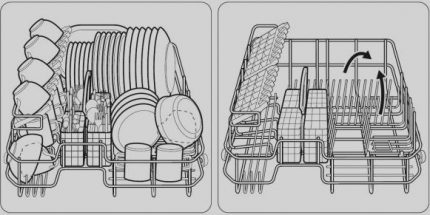
Full-size and narrow units are equipped with 2-3 boxes for loading. This is convenient for standard programs when the lower sector is subjected to more efficient cleaning. And also for individual modes, for example, “delicate”, when only glass or crystal glasses are installed, which are installed in the upper basket.
Under the boxes and above them are rocker arms that spray water. During operation, they rotate, so it is important to monitor the placement of tall objects in order to prevent damage to the sprinklers.

Sometimes it is necessary to wash things that do not fit in the lower compartment. Then remove the upper basket, conveniently install objects and start the machine with one basket. Deep containers are placed with a recess down, so that water flows freely along the walls.
It is believed that the lower compartment of the machine is processed more aggressively and at elevated temperatures. Therefore, the plastic and most fragile serving items are usually placed at the top. Proper placement of dishes - An important step in the daily use of the machine.
The subtleties of operating PMM
You have to use a dishwasher every day, so it is important to take into account all the nuances of care, from the choice of detergents to regular cleaning.
Consider the most important points that you have to deal with constantly when starting up the machine or after several washes.
Choice of detergents
If you correctly select tablets, gel, powder and other detergents, you will not have to replace failed parts, rinse the glasses in addition or wash the most contaminated items.
When choosing tools, we recommend that you study the manufacturer’s recommendations, user reviews, learn more about new safe developments. There are a series of eco-products, the least harmful to health, but sparing for dishes. They perfectly wash baby bottles and drinkers, but they may not be able to cope with a fat pan.
The most popular brands: BioMio, Claro, Finish, Minel, Aonite, Clean & Fresh, FeedBack, Filtero.

An important rule: ordinary detergents for manual processing of dishes are not suitable. Using homemade remedies care must also be taken. Chlorine is prohibited to add.
Powder or tablet replacement
Modern electronic models of dishwashers themselves suggest when to pour powder, salt or put a tablet. The indicator on the electronic panel lights up in red or orange to warn of a replacement.
You can start the cycle without any detergents, but washing will be comparable to rinsing under hot water - there may be traces of dried food or a layer of fat.
Least of all you have to fall asleep regenerating salt, since the volume of one dose is designed for several weeks of work. At the first loading, it is recommended that 1/3 of the compartment be filled with large crystals of salt, and 2/3 - with water. If complex tablets are used instead of salt, replacement occurs more often.
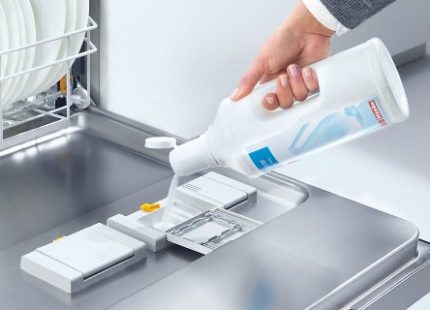
When buying funds for future use, pay attention to the expiration date. It is also necessary to take into account storage conditions so that chemicals do not lose their strength.
Filter Cleaning Instructions
The filtration system - usually 2-3 filters installed in the lower part of the washing chamber - needs to be cleaned regularly, without waiting for complete clogging with dirt.

The grease is also not washed off completely, and sooner or later it will be necessary to clean the filters, even if you load almost clean dishes and apply cleaning agent, which necessarily contain fat-soluble substances.
Procedure:
- Disable PMM. If there is no access to the outlet, then turn off the machine on the shield.
- Use a rag or foam sponge to remove residual water at the bottom.
- Unscrew the upper part and remove the filters.
- Disconnect fine filter.
- Brush all elements and rinse with detergent.
- Replace by inserting and screwing in the reverse order.
When cleaning, use toothbrushes and special kitchen brushes, powders, gels, baking soda.
If white streaks or deposits are noticed, a lime removal procedure is necessary. Apply compounds that dissolve plaque, and if there is no special equipment, then ordinary citric acid.
Regular Maintenance Rules
Not only filters can suffer from dirt, but also the walls of the chamber, sprinklers, separation of loading baskets. The simplest thing a user can do is to manually wipe all parts from time to time with a damp cloth using a mild detergent solution.
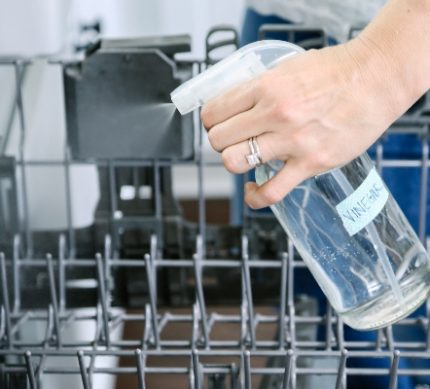
A preventive chemical will help protect internal parts from mold, greasy deposits or other dirt. dishwasher cleaning.
Work execution order:
- free all boxes from dishes;
- powder cuvette fill special means for cleaning the dishwasher;
- choose one of the long programs, for example, “standard”.
The temperature of the water during washing should be above +60 ° C, so that cleaning products act as efficiently as possible, and all impurities are dissolved and washed off into the sewer. Dry cleaning is recommended at least every 4-6 months.
The door is usually wiped manually, carefully processing not only the front glass, but also the seals.

In order for the drainage system to work properly, you must also rinse the drain hose. It is unscrewed, rinsed with anti-fat detergent compositions and fixed in place.
Returning all parts to their places, it is necessary to tightly tighten the union nuts and check the tightness of the connections before switching on. If the work is not performed carefully, a slight flood is possible during washing.
Conclusions and useful video on the topic
Quickly and accessible about cleaning filters in the following video:
Useful user tips for servicing a household dishwasher:
Overview of popular PMM tablets from the owner of the dishwasher:
Video instructions for filling salt will help to understand the nuances of this procedure:
Regular cleaning and treatment of the working area of the dishwasher will not only save you from the unpleasant odor of the sewer, but also increase the life of the machine. Schedule preventive and cleaning care measures and act strictly according to plan.
Soon it will become a habit, and a diligent assistant will always ideally wash the dishes in any of the selected programs, and an urgent repair is not required.
Please write comments in the block below, ask questions and post photos on the topic of the article. Tell us what rules you follow when using the dishwasher. Share useful information that may be useful to site visitors.

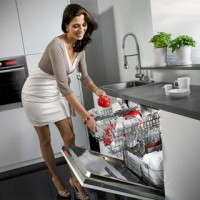 How to use a Bosch dishwasher: rules and nuances of operation
How to use a Bosch dishwasher: rules and nuances of operation  The principle of operation of a typical dishwasher: design, main components, operating rules
The principle of operation of a typical dishwasher: design, main components, operating rules  What tablets are best for a dishwasher: what to choose for the care of appliances
What tablets are best for a dishwasher: what to choose for the care of appliances 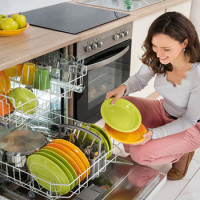 How to load dishes in the dishwasher: the rules of operation of the dishwasher
How to load dishes in the dishwasher: the rules of operation of the dishwasher 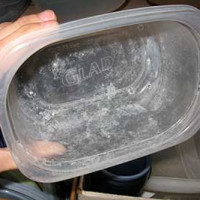 Why does white plaque appear in the dishwasher and how to get rid of it
Why does white plaque appear in the dishwasher and how to get rid of it  The first start of the dishwasher: how to properly carry out the first inclusion of equipment
The first start of the dishwasher: how to properly carry out the first inclusion of equipment  How much does it cost to connect gas to a private house: the price of organizing gas supply
How much does it cost to connect gas to a private house: the price of organizing gas supply  The best washing machines with dryer: model rating and customer tips
The best washing machines with dryer: model rating and customer tips  What is the color temperature of light and the nuances of choosing the temperature of the lamps to suit your needs
What is the color temperature of light and the nuances of choosing the temperature of the lamps to suit your needs  Replacement of a geyser in an apartment: replacement paperwork + basic norms and requirements
Replacement of a geyser in an apartment: replacement paperwork + basic norms and requirements
We watched the first wash with the whole family, the process itself was very interested. And the first load showed that we laid the dishes incorrectly, as there were plates that did not clean. So you need to get used to the download for a while. Now this procedure takes a minimum of time. Choosing a detergent is also not a simple matter. I want it to flawlessly launder and be safe. The first time we bought a cheap composition, there were white stains on the plates, we had to rinse the dishes manually. Now settled on Finish.
Our friends, apparently, incorrectly chose a dishwasher. They took too much, and as a result, the dishes were “hoarded”. While it accumulates, the smell of food leftovers on dishes begins to appear in the kitchen, which slowly deteriorates, especially in the heat. We are now at the stage of choice - to take a compact or full-size car. Does the full-size have some kind of half-load modes, like the washing machines?
The special function “Half load” is now on many modern dishwashers. This mode allows you to significantly save water and energy consumption, as well as to avoid the problem of a long accumulation of dishes and the occurrence of an unpleasant odor from food debris from plates. The only disadvantage of this mode is the difficulty with using 3 in 1 tablets. You have to divide them manually.
And on the most sophisticated dishwashers in general there are special sensors that scan the number of dishes and the degree of its pollution. After that, the computer independently determines how intensive washing is needed.
Olga, hello!
Dishwasher capacity is considered in sets. Full-size machines wash from 11 to 18 sets in one load, compact ones from 6 to 9. One set is a set of dishes and kitchen utensils, necessary for a full dinner for one person. The set includes: a soup plate, a small plate, a salad bowl, a cup and saucer, a glass, a set of cutlery. When choosing PMM, determine how often you plan to wash the dishes: after each meal, 1 or 2 times a day, etc.
Next, based on the number of family members, count the number of sets of utensils that accumulate from washing to washing. When calculating, you can replace the soup plates with salad bowls or plates for the second dishes. Thus, you will find out the number of sets that will accumulate at the time of washing.
For a family of two, a compact machine for 6 sets is enough when washing dishes 1-2 times a day. For a family of 4-5 people, a dishwasher for 11-14 sets is suitable. If you have a large family or you often cook a lot, receive guests, then the PMM for 14-18 sets will suit you.
Yes, dishwashers have a half load mode, to be honest, I have no idea how people use mmm, where there is no half load. When we bought our PMM, we first of all turned it over, and how you say storing dishes is still a pleasure.